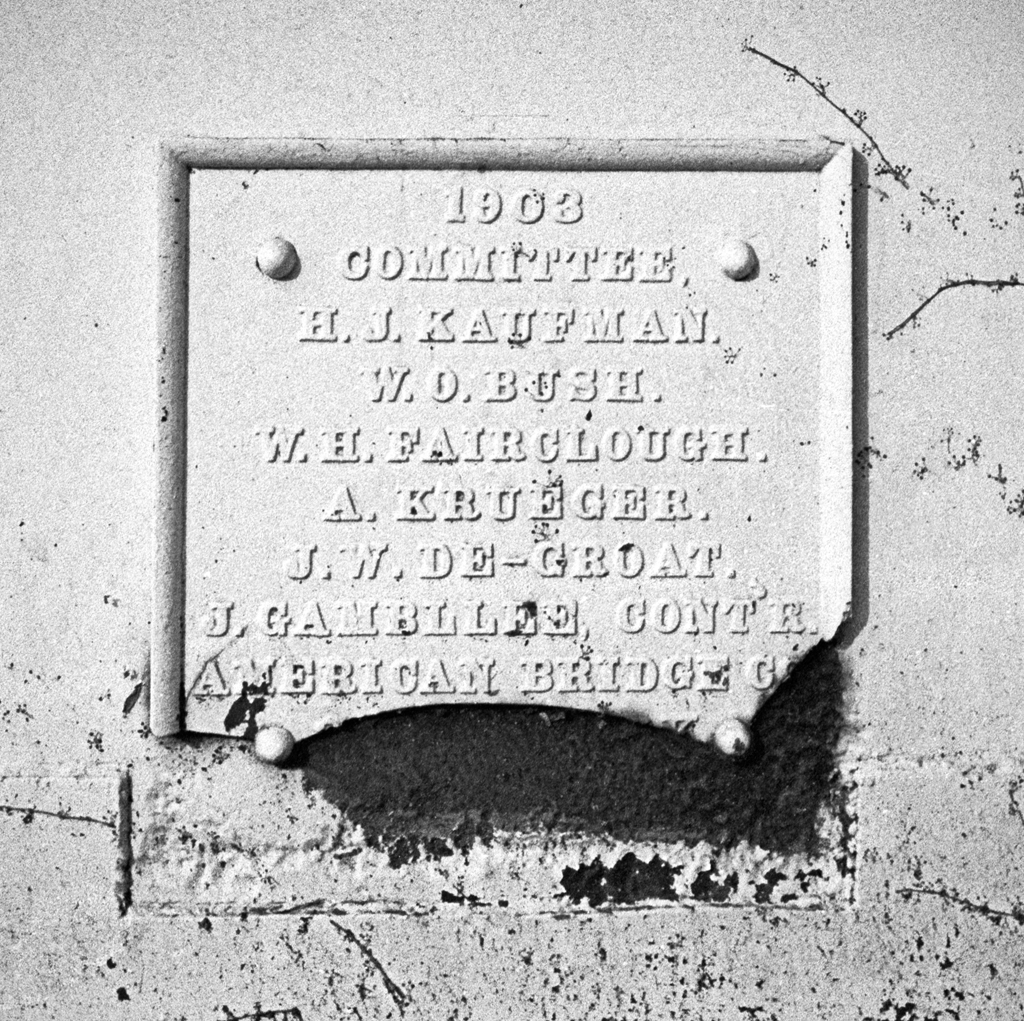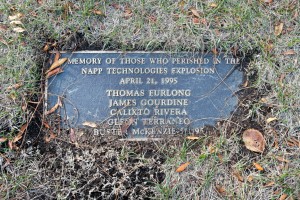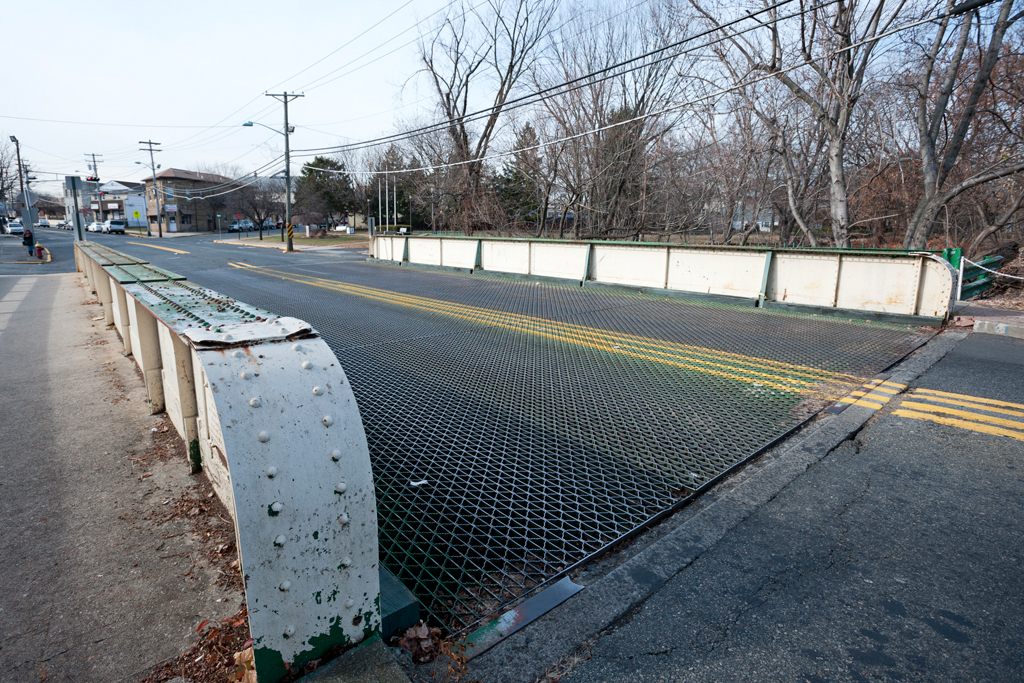
Crosses: Saddle River
Location: Carries Passaic Street over the Saddle River in Lodi, NJ [satellite map]
Carries: 2 vehicular lanes, 2 pedestrian sidewalks
Design: Through-girder bridge
Date opened: 1903
The Passaic Street Bridge carries Passaic Street (which becomes Passaic Avenue and feeds into Main Street) across the Saddle River in Lodi, New Jersey. It was built by the American Bridge Company in 1903. It is a through-girder bridge that rests on stone abutments. In 1939 (and again in 1971), the girders underwent repairs and welded plates were added to strengthen them. Also in 1971, much of the original concrete encasement on the floorbeams was removed and a metal deck was installed. Some of the original metal railing remains on the span, and one partially-broken plaque gives information on the bridge’s construction. New Jersey’s 2002 Bridge Survey notes that the bridge is one of more than 20 of its type in the state, and due to the construction on it over the years, “the altered span has lost its visual integrity and it is not distinguished.” [1]

Though the bridge may not be unique in its construction, it is of a type that is frequently replaced with more modern spans, and over its 110-plus years in existence it has been witness to much change in Lodi.
Industry on the Saddle River
The town of Lodi has existed in some form since Revolutionary times, and the township of Lodi was organized in 1825, taking its name from a town in Italy. The Saddle River was important to the growth of the town into a manufacturing center. By the late 1800’s, the river provided the power to two grist- and saw-mills, a bleaching and dyeing factory called United Piece Dye Works, and the Lodi Chemical Works. [2]
The borough of Lodi was incorporated in 1894 out of Lodi Township and Saddle River Township, during New Jersey’s period of “Borough Fever” of the late nineteenth century. Starting in 1894, New Jersey allowed new boroughs to be formed by petition, rather than as a special act of the state legislature. Bergen County took particular advantage of this–56 out of 70 total municipalities in the county are now boroughs.
United Piece Dye Works
The late 1890’s saw an influx of immigrants, mainly from Italy, coming to Lodi to work at the United Piece Dye Works. The factory was just upstream from the current location of the Passaic Street Bridge on the Saddle River. The dye made there became a part of the landscape. Anthony Taormina, who was born in Lodi in 1954 and went on to become the director of its library from 1986 until his retirement in 2011, described the Dye Works’ effect on the the river:
“I remember my mother telling me about walking over the Passaic Street bridge on her way to school, looking at the different chemical colors coming down the Saddle River. One day it would be green, one day it would be blue, depending on what color they were dying that day.” [3]
Chemical Manufacturing

During the Great Depression, much of the textile business that had been in and around Passaic, NJ moved south in order to cut labor costs. United Dye Works closed in the 1950’s and soon chemical manufacturers moved into the town.
An explosion tore the roof off a building at the B.L. Lemke Company in April of 1969, killing one person and wounding six. In August of 1973, an explosion at the Mallinckrodt Chemical Company killed seven employees. After that incident, the town cracked down somewhat on the industry: it prohibited new chemical companies from moving in and prevented the existing ones from expanding further.
B.L. Lemke later became Napp-Lemke Chemicals, and later still Napp Technologies. In April of 1995 another explosion rocked the complex, killing five and injuring seven. Approximately 400 residents of Lodi were evacuated. The Saddle River turned a fluorescent green color from the chemically contaminated water runoff generated by firefighting efforts at the plant.
Lodi’s problems with chemicals weren’t limited to explosions. The town once got its water from natural wells, run by the Lodi Water Works. In 1983, they were shut down after it was discovered that they had been contaminated by thorium, a radioactive chemical made in Lodi by another chemical company. Water has been piped in from elsewhere ever since.
Legislation introduced after the Napp Technologies explosion prevented the company from reopening in Lodi. The area it once occupied now is parkland and a shopping area.
Flooding
The Saddle River has flooded many times over the years. In March 1902 the water rose 14 inches above the previous bridge. Though no information has been found to support this, it can be speculated that the bridge was replaced in 1903 because of damage done during the 1902 flood (this was the case with many bridges over the nearby Passaic River). An even larger flood occurred in October of 1913: the Saddle River reached a height of six-and-a-half feet above the bridge [4]. Floods continue today and local officials have attempted to pass legislation which would allow for dredging of the river, but the estimated cost of $100 million has held the project back [5].
